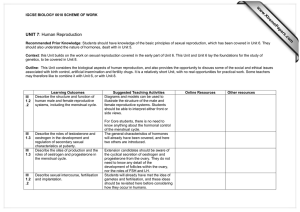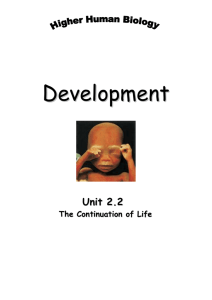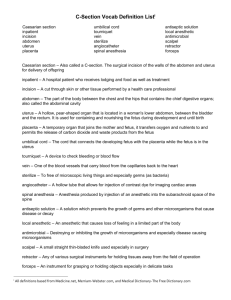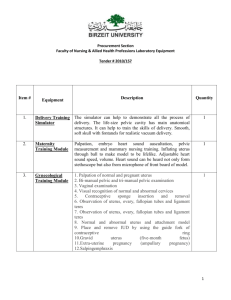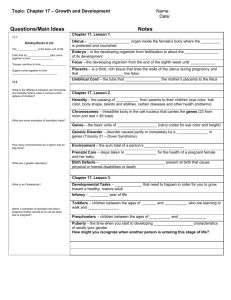UNIT 7
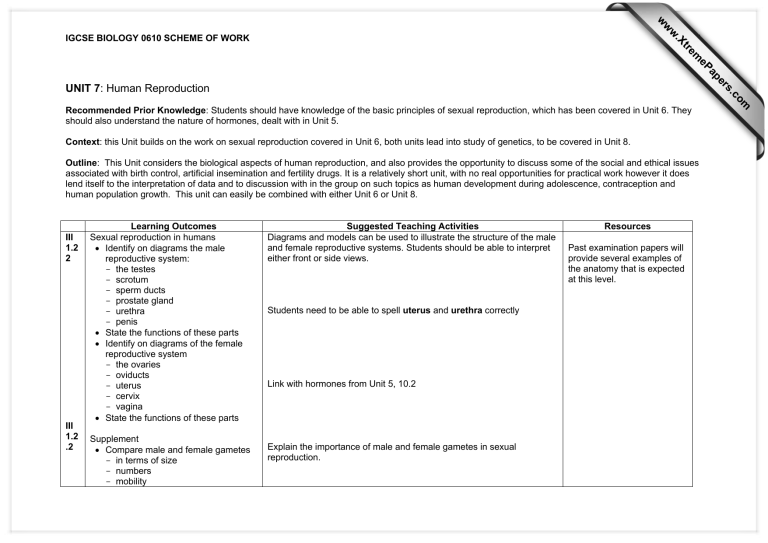
www.XtremePapers.com
1 IGCSE BIOLOGY 0610 SCHEME OF WORK
UNIT 7 : Human Reproduction
Recommended Prior Knowledge : Students should have knowledge of the basic principles of sexual reproduction, which has been covered in Unit 6. They should also understand the nature of hormones, dealt with in Unit 5.
.2
III
1.2
III
1.2
2
Context : this Unit builds on the work on sexual reproduction covered in Unit 6, both units lead into study of genetics, to be covered in Unit 8.
Outline : This Unit considers the biological aspects of human reproduction, and also provides the opportunity to discuss some of the social and ethical issues associated with birth control, artificial insemination and fertility drugs. It is a relatively short unit, with no real opportunities for practical work however it does lend itself to the interpretation of data and to discussion with in the group on such topics as human development during adolescence, contraception and human population growth. This unit can easily be combined with either Unit 6 or Unit 8.
Learning Outcomes
Sexual reproduction in humans
•
Identify on diagrams the male reproductive system:
the testes
Suggested Teaching Activities
Diagrams and models can be used to illustrate the structure of the male and female reproductive systems. Students should be able to interpret either front or side views.
Resources
Past examination papers will provide several examples of
•
-
-
-
-
-
-
-
-
scrotum
sperm ducts
prostate gland
urethra
penis
•
State the functions of these parts
Identify on diagrams of the female reproductive system
the ovaries
oviducts
uterus
cervix
vagina
•
State the functions of these parts
Supplement
•
Compare male and female gametes
in terms of size
numbers
mobility
Students need to be able to spell
Explain the importance of male and female gametes in sexual reproduction. uterus
Link with hormones from Unit 5, 10.2
and urethra correctly the anatomy that is expected at this level.
IGCSE BIOLOGY 0610 SCHEME OF WORK
III
1.2
.2
Learning Outcomes
Core
•
Describe the menstrual cycle in terms of changes in the uterus and ovaries
Supplement
•
Explain the role of hormones in controlling the menstrual cycle
FSH
LH
progesterone
oestrogen
Core
•
Outline sexual intercourse and describe fertilisation in terms of the joining of the nuclei of male gamete
(sperm) and the female gamete(egg)
•
Outline early development of the zygote simply in terms of the formation of a ball of cells that becomes implanted in the wall of the uterus
•
Outline the development of the fetus
Supplement
•
Indicate the functions of the amniotic sac and the amniotic fluid
Core
Describe the function of the placenta and the umbilical cord in relation to
exchange of dissolved nutrients
gases
excretory products
(no structural details of the placenta are required.
Suggested Teaching Activities
Students should draw a chart / graph and write in the hormones (in different colours) at the relevant times within the cycle.
The role of hormones and the effect on the uterus and menstruation are difficult to understand.
It should be emphasised that ovulation occurs monthly and that the cycle is repeated throughout a woman's fertile life.
Mention that fertilisation usually takes place in an oviduct, rather than the uterus.
Protection of the fetus, the amniotic sac prevents entry of bacteria and the amniotic fluid supports the fetus from physical damage and absorbs the excretory materials of the fetus.
Diagrams should be drawn to show the relationship between the fetus, umbilical cord and placenta.
The large surface area of the placenta can be compared to that of the villi or the alveoli that allows for the maximum diffusion across the membrane.
Understand that maternal blood and foetal blood do not mix. The mother may have a different blood group and her blood is at a much higher pressure.
Students should understand that glucose and amino acids cross the placenta, not 'large' nutrients. Oxygen, glucose and amino acids diffuse into the blood of the fetus.
Resources
2
IGCSE BIOLOGY 0610 SCHEME OF WORK
III
1.3
Learning Outcomes
•
Describe the ante-natal care of pregnant women including special dietary needs and maintaining good health
•
Outline the processes involved in labour and birth.
Supplement
•
Describe the advantages and disadvantages of breast-feeding compared with bottle-feeding using formula milk
Sex hormones
•
Describe the roles of testosterone and oestrogen in the development and regulation of secondary sexual characteristics at puberty.
Supplement
•
Describe the sites of production and the roles of oestrogen and progesterone in the menstrual cycle and in pregnancy (cross reference to supplement III. 1.2.2)
Suggested Teaching Activities
It is important to emphasise the importance of the mother's diet during pregnancy and to emphasise the possible problems incurred by the fetus if the mother smokes, drinks, takes recreational drugs
Link with Unit 5. 10.5
Mention that hormones are involved in the process of birth.
Discussion on the topic of birth may need to be controlled and it can be important for the teacher to have some knowledge of the group's family situation as many students will talk about cot deaths, still born babies, caesarean section births, miscarriages etc
This topic can be dealt with through discussion, perhaps after students have done a little research of their own. The biological advantages of breast-feeding are incontrovertible, but students should also be aware of social and health reasons why there are benefits to breast feeding
The general characteristics of hormones will already have been covered, and here the sex hormones are introduced.
Puberty is when the sex organs become mature and start to produce hormones as well as gametes.
Students can make a table to compare the secondary sexual characteristics as shown by male and female.
This can be a difficult topic to understand and past questions are a means of reinforcing the ideas. Candidates should be aware of the cyclical secretion of oestrogen and progesterone from the ovary.
Progesterone is also secreted by the placenta during pregnancy.
Resources http://cyberparent.com/breast feed/ some mothers find this difficult and prefer to use formula milk.
And www.nct.org.uk
is informative on breast feeding.
3
IGCSE BIOLOGY 0610 SCHEME OF WORK
III
1.4
III
1.5
Learning Ou c
Methods of birth control
•
Outline the following methods of birth control:
natural (abstinence, rhythm control)
chemical (contraceptive pill, spermicide)
mechanical (condom, diaphragm, femidom, IUD)
surgical (vasectomy, female sterilisation)
Supplement
•
Outline artificial insemination and the use of hormones in fertility drugs and discuss their social implications
Sexually transmissible diseases
•
Describe the symptoms, signs, effects and treatment of gonorrhoea.
•
Describe the methods of transmission of human immunodeficiency virus (HIV) and the ways in which HIV/AIDS can be prevented from spreading.
Supplement
•
Outline how HIV affects the immune system in a person HIV/AIDS
Suggested Teaching Activities
A simple description of the biological basis of the different types of birth control is required.
Students should also understand the relative effectiveness of each, and may want to discuss the ways in which religious or cultural beliefs can affect their use. Students should be shown examples of each type of contraceptive if at all possible.
The advantages of condoms in reducing the risk of transmitting diseases such as HIV /AIDS should also be considered.
A simple factual treatment of what artificial insemination is, and the use of fertility drugs, will be required before students can discuss the social and ethical issues associated with it. These issues regularly find their way into the news, and it is useful to collect a range of articles from newspapers and magazines that could form the basis for discussion.
Gonorrhoea is used as an example of a relatively common sexuallytransmitted disease caused by a bacterium, readily treated with antibiotics.
Link with Unit 5.10.5
HIV, on the other hand, is caused by a virus, and as yet no cure is available.
Although no detail is expected of the symptoms of AIDS, it could be useful to deal with these briefly, with reference back to the functions of white blood cells in
Unit 4.7.2.3 and to the importance of using a mechanical barrier such as a condom during sexual intercourse if the person does not have a single partner.
Link with Unit 5 II.10.5, the action of antibiotics on bacteria but not on viruses.
Resources
4
